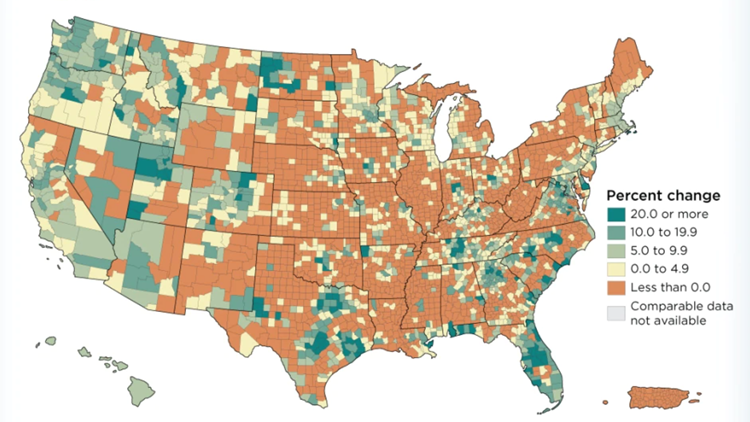JACKSONVILLE, Fla. — The Jacksonville area gained about 260,000 people over the past decade, pushing the population to 1.6 million as people of increasingly varied colors and backgrounds made homes in Northeast Florida, census data released Thursday showed.
Duval County’s population fell less than 4,500 short of one million people, a milestone it has almost certainly passed in the 16 months since the U.S. Census Bureau’s decennial headcount.
The five-county Jacksonville metro area grew by nearly one fifth since 2010, fueled by a phenomenal 43.9 percent growth rate in St. Johns County and a 76.4 percent rise in the metro area’s Hispanic population.
Northeast Florida’s growth has brought jobs and development to places that worked diligently to cultivate both.
Census breakdown: See what the 2020 census said about counties across Florida
Development in the pipeline:Downtown Jacksonville hotel building to get $4 million overhaul
Diverse community:A Jacksonville local couldn't find diverse authors in bookstores — so she started her own
But reaching that goal has made some residents protective of things they’ve always had.
"We know we have something special here. We want to keep it special," said St. Johns County Commissioner Jeremiah Blocker. "So when you see those type of growth numbers, I mean, that's astounding.”
In addition to St. Johns’ eye-popping rate, Duval County grew by 15.2 percent while Nassau County had a rate of 23.2 percent, Clay County grew by 14.3 percent and Baker County increased by 4.2 percent.
How to keep the area’s charms while welcoming development remains a puzzle.
"There is a balancing act that needs to happen between growth and remaining true to who we are,” said Wendell Chindra, president of the Clay County Chamber of Commerce.
“The biggest thing we have going for us is the quality of life," he said. "The things that we cherish the most and we consider great [are] quality of life, the river, the suburb and rural type community where you still have the trees and the parks."
About 40 percent of Jacksonville area's growth came from multiracial people
Those traditional pleasures are increasingly being shared by people whose backgrounds are more complicated than traditional images of Northeast Florida life.
Roughly 40 percent of the area’s population increase came from people the census counted as having two or more races, and another 13 percent were identified as “some other” race.
Chindra, whose ancestry is Indian and Trinidadian, said the increasing diversity is evident in the people coming to the Clay Chamber planning to open businesses.
"I had a Hispanic guy a few weeks ago come in looking to open a local gym. One called me yesterday and he's African American and he was looking to open almost the same thing, another type of gym, but in a different part of town," Chindra said. He added that parts of the county seem to have concentrations of people from distinct backgrounds.
"The Hispanic folk, I think a lot of them are going to move into the Lake Asbury, Branan Field area,” he said. “African Americans are very centralized in Oakleaf and they like that area, I think, because of the commute and a lot of them are military."
Duval County’s growth rate, 15.2 percent, was more modest than parts of Northeast Florida, but Jacksonville plays a key role in the region’s growth, said Ray Oldakowski, a geography professor at Jacksonville University.
When migration raises the population, new arrivals tend to move first into Duval County, he said, then some shift to suburban counties after some time in the area.
What happens after Census data is released?
The data released Thursday didn’t address migration, or how many people were new to the area, or even the number of men and women.
The counts were figures the Census Bureau is legally required to provide so state and local governments can begin the redistricting process that set boundaries for candidates running for elected seats ranging from Congress to Jacksonville’s City Council and many smaller boards. Counts of racial and Hispanic identity are required by law.
The rest of the once-a-decade census data will be parceled out in months to come, outlining anonymized information about residents’ education, income, jobs, family size, even languages they speak and whether they served in the military.
All of those questions are used by governments to decide what services should be provided where and for local governments to build their plea that their communities deserve additional shares of federal or state tax money to pay for those services.
Jacksonville spent $150,000 on a campaign to encourage people to complete their census forms and increased the response “self-response,” or voluntary, rate substantially compared to 2010.
The census results show Northeast Florida outpaced the state as a whole, where population grew by 14.6 percent to 21.5 million. The United States population grew by 7.4 percent to 331.4 million.
While the rising population strains roads and raises expenses for local governments, people who’ve banked on development helping the area economically have celebrated the growth the region has experienced.
“It’s pretty incredible, isn’t it?” said Sherri Mitchell, interim executive director of the Nassau County Economic Development Board, who was late for an interview because she was talking to an aerospace firm considering a project in her area. “It’s great when you start to see the fruition of all the work from past leaders.”
Click here to read more from the Florida Times-Union.



